
Hekate, also known as Hecate, is a figure of significant intrigue and complexity within ancient Greek religion and mythology. She is often depicted holding a pair of torches or keys and is associated with crossroads, the night, and the underworld.
The earliest literary mention of Hekate can be found in Hesiod’s “Theogony,” where she is portrayed as a powerful deity with dominion over earth, sea, and sky, bestowed with honours by Zeus himself. This depiction aligns with her role as a universal goddess, a giver of wealth and prosperity, and a protector of the household. However, as time passed, Hekate’s image transformed into that of a chthonic deity, associated with the underworld, spirits, and the darker aspects of magic.
Origin myths for Hekate
Hekate’s origins are shrouded in mystery, with some scholars suggesting a pre-Greek origin while others propose she was a later addition to the Greek pantheon from regions such as Caria in Asia Minor. Her earliest literary mention is in Hesiod’s “Theogony,” where she is honoured as a goddess of the sky, earth, and sea, reflecting her liminal role as a deity of boundaries and transitions.
The scholarly debate leans towards a pre-Greek origin, possibly in the regions of Anatolia. Carol M. Mooney’s thesis, “Hekate: Her Role and Character in Greek Literature from before the Fifth Century B.C.,” provides a comprehensive examination of Hekate’s representation in early Greek texts, such as the Theogony and the Homeric Hymn to Demeter, suggesting that the darker aspects commonly associated with Hekate in later periods were not present in her earliest depictions.
This aligns with findings from William Berg’s article “Hecate: Greek or ‘Anatolian’?” which challenges the prevailing view of Hekate’s non-Greek origins, proposing instead that she may have as much right to a Hellenic pedigree as other Olympians, based on the evidence of personal names and cult practices found in Caria during the fifth and fourth centuries B.C. Furthermore, the University of Victoria’s research on “Hekate in early Greek religion” highlights the archaeological evidence concentrated around the Aegean Sea and western Anatolia, suggesting Hekate’s association with the “Great Goddess” figure common to Anatolia, yet cautioning against confining her origins to a specific region.
Hekate, a figure of great intrigue and complexity within the Greek pantheon, is indeed a subject of scholarly debate regarding her origins. The goddess, known for her associations with magic, witchcraft, and the crossroads, presents a multifaceted persona that has evolved over time. While some sources suggest Hekate’s roots can be traced back to Caria in Asia Minor, others propose that her inclusion in the Greek pantheon was a result of syncretism, a common practice in ancient religions where deities from different cultures merge and assimilate attributes from one another.
Hekate’s worship in Caria, particularly at the sanctuary of Lagina, highlights her importance in the region and suggests a possible origin point for her cult. The archaeological evidence, such as the oldest-known representation of Hekate found in Selinunte, Sicily, supports the theory of her widespread veneration across the Mediterranean, indicating a complex interplay of cultural influences that shaped her worship.
Moreover, Hekate’s syncretic nature is evident in her assimilation of attributes from other deities, such as Artemis and Selene, which further complicates the understanding of her original form and function. Her titles and epithets, ranging from “Saviour” to “Leader of Dogs,” reflect the diverse and sometimes contradictory aspects of her character.
In conclusion, while Hekate’s origins may remain shrouded in mystery, the available literary and archaeological evidence points towards a deity whose worship was significant and widespread, with roots that may extend to the pre-Greek cultures of Asia Minor. Her evolution within the Greek pantheon serves as a testament to the dynamic and syncretic nature of ancient religious practices.
These sources collectively contribute to the understanding of Hekate’s multifaceted character and the evolution of her worship from a potentially benevolent deity in pre-Greek times to the more complex figure known in classical antiquity. The transformation of Hekate’s image over time reflects the intricate process of cultural and religious syncretism, as well as the shifting landscapes of myth and memory in the ancient world.
Hekate in Greek mythology
In Hesiod’s “Theogony,” she is described as the daughter of the Titans Perses and Asteria, and is associated with a wide range of domains, including the sky, earth, and sea, which bestowed upon her great honour and power.
Hekate’s functions and symbols are diverse and significant. She is often depicted holding torches, a key, and is accompanied by dogs, all of which signify her roles as a goddess of light, magic, protection from witchcraft, and her dominion over the crossroads, the night, and the thresholds between worlds. This multifaceted nature is reflected in her iconography, where she is sometimes shown as three-formed or triple-bodied, symbolizing her power over the heavenly, earthly, and chthonic realms.
Hekate in Roman mythology
The Romans, too, revered Hekate and frequently associated her with Diana and Artemis, goddesses of the hunt and moon, under the epithet Trivia, which refers to her guardianship over crossroads. In art and sculpture, Hekate’s portrayal evolved from a singular figure to a triadic form, which further emphasizes her role as a liminal deity, capable of moving between worlds and wielding influence over multiple realms.
In later periods, particularly during the Hellenistic and Roman eras, Hekate’s attributes expanded, and she was sometimes addressed as Soteira, signifying a saviour, and as the Cosmic World Soul, Anima Mundi, highlighting her universal significance. Her association with the spiritual world, ghosts, and the dead was also pronounced, as evidenced by her role in the myth of Demeter and Persephone, where she aids in the search for Persephone and later becomes her companion during her annual journey to and from the underworld.
Origin of the name Hekate
The origin of Hekate’s name is as enigmatic as her nature. Some scholars suggest it may derive from a Greek root such as “hekon,” meaning “will,” implying a connection to her wilful attributes, or from “Hekatos,” an obscure epithet of Apollo, which could be interpreted as “the far-reaching one” or “the far-darter”. However, these etymologies are speculative and reflect the broader challenges in pinpointing the precise origins of Hekate’s worship and name.
The complexity of Hekate’s character is reflected in her iconography, which sometimes presents her as three-formed or triple-bodied, symbolizing her power over the crossroads and her ability to see in multiple directions simultaneously. This aspect also aligns with her role as a guardian of the household and protector of the threshold, both literal and metaphorical.
In later periods, particularly during the Roman era, Hekate’s identity merged with that of Diana and Artemis, further complicating her narrative and functions. She was venerated in various locales, most notably in Lagina, where a significant sanctuary dedicated to her attracted worshippers from across the region. The Romans knew her as Trivia, emphasizing her dominion over the three-way crossroads.
The scholarly debate continues regarding the precise nature of Hekate’s cult and her place within the Greek religious framework. She is described as more at home on the fringes of Greek polytheism, embodying a nature that is both ambivalent and polymorphous. This ambiguity is perhaps what makes Hekate an enduring subject of fascination for both ancient worshippers and modern scholars alike.
Hekate’s role in witchcraft
Hekate’s association with witchcraft in Greek mythology is profound and multifaceted, reflecting her complex nature as a deity. She is often depicted as a powerful figure who governs over magic and the occult, wielding influence over necromancy, ghosts, and the night. Her role as a goddess of witchcraft is not merely about the dark arts; it also encompasses her position as a protector and guardian, overseeing the thresholds of the home and the boundaries between the mortal and supernatural realms.
In ancient texts, Hekate’s powers are described as immense, particularly during the night when her influence is believed to be at its peak. This nocturnal strength ties her to the moon and its cycles, further cementing her connection to the mystical and the unseen. As a deity who operates within the margins, Hekate embodies the very essence of transition, guiding souls through the journey from life to death and beyond.
The reverence for Hekate in witchcraft extends beyond the ancient world into modern practices. Many contemporary witches view her as a patroness of their craft, invoking her name in rituals and seeking her guidance at the crossroads of their spiritual journey. Her symbols, such as the torch, key, and dagger, serve as tools for focusing intent and channelling magical energies.
Hekate’s enigmatic origins contribute to her role in witchcraft. Some scholars suggest she may have been another name for Artemis, whose darker aspects were later personified as Hekate. Others propose that she originated in Asia Minor, particularly in Caria, where she was the primary deity worshipped. This blend of Greek and Anatolian influences likely enriched her attributes as a goddess of magic and mystery.
The portrayal of Hekate in literature and art often emphasizes her triple form, which symbolizes her power over the crossroads and her ability to see in multiple directions—into the past, present, and future. This aspect of her iconography aligns with her role as a guide and protector, one who stands at the intersection of the physical and spiritual worlds.
Despite her associations with the darker elements of mythology, Hekate is not depicted as an evil deity. Instead, she occupies a neutral space, embodying the duality of light and shadow. Her role in witchcraft is thus one of balance, offering wisdom and protection to those who seek her out, while also commanding the forces that dwell in the hidden corners of the world.
Hekate’s role in witchcraft is emblematic of her broader significance in Greek mythology—as a guardian of the liminal, a master of the arcane, and a guide for those traversing the uncertain paths of existence. Her legacy continues to inspire and intrigue, a testament to the enduring power of myth and magic in human culture.
Some Hekate inspired rituals
The rituals associated with Hekate are as diverse and complex as the goddess herself, reflecting her multifaceted nature and the various domains over which she presides. One of the most well-known rituals is the Deipnon, which translates to ‘supper’ in Greek, traditionally held at the new moon. This ritual involves leaving offerings at crossroads, which are sacred to Hekate as places of decision-making and transition. Offerings typically include food that is not consumed by humans but left for Hekate and the spirits that accompany her, such as dogs, which are her sacred animals. This act of giving honours the goddess and purifies the household, as it is believed to appease any restless spirits or negative energies.
Another ritual is the preparation of Hekate’s Supper, which involves setting a meal outside the home or at a crossroads, often consisting of eggs, fish, and garlic, foods associated with her cult. This offering is meant to ensure Hekate’s favour and protection over the household and its inhabitants. Additionally, practitioners may carry out rites that involve the use of symbols and tools associated with Hekate, such as keys, to unlock the mysteries of the universe or to protect against the unknown.
Hekate is also honoured through the creation of altars and shrines, where devotees can leave offerings, light torches or candles, and recite prayers or incantations. These altars may be erected at crossroads, in gardens, or within the home, serving as a focal point for worship and meditation. The lighting of torches or candles is particularly significant, as it symbolizes the illumination of the dark and the guidance Hekate provides.
In modern practices, followers of Hekate may adapt ancient rituals or create new ones that resonate with their personal connection to the goddess. This could involve the use of modern-day items as offerings, such as coins or written prayers, or the incorporation of contemporary symbols that hold personal significance. The key element in all these rituals is the intention to honour Hekate’s wisdom, her protective powers, and her role as a guide through life’s transitions.
The practice of Hekatean witchcraft today often includes the use of herbs, incense, and crystals in rituals, drawing on Hekate’s association with herbalism and magic. Practitioners may also engage in divination, seeking Hekate’s insight into the future or guidance on a particular issue. These rituals are deeply personal and can vary widely among individuals, but they all share a common goal: to connect with the divine energy of Hekate and to seek her blessings.
Prayers and invocations for Hekate
Prayers and invocations to Hekate are a testament to her enduring legacy as a deity of the crossroads, magic, and the liminal spaces between worlds. These sacred texts serve as a bridge for devotees to connect with the divine essence of Hekate, seeking her guidance, protection, and wisdom. One of the most ancient and revered texts is the Orphic Hymn to Hekate, which honours her as the mistress of the crossroads and the keeper of the keys to the cosmos. This hymn is often recited during rituals to invoke her presence and blessings.
A traditional invocation might begin with a respectful address to the goddess, acknowledging her dominion over the thresholds of existence and her role as a guide for souls. Devotees may call upon her many epithets, such as Hekate Phosphoros, the light-bringer, or Hekate Kleidouchos, the key-bearer, each reflecting a different aspect of her vast powers. The language used in these prayers is typically poetic and rich with imagery, evoking the multifaceted nature of the goddess.
In addition to the Orphic Hymn, there are numerous other prayers and chants that have been crafted over the centuries, each tailored to specific aspects of Hekate’s mythology. For instance, a prayer to Hekate as the protector of the household might implore her to guard the home and its inhabitants against malevolent forces. Similarly, an invocation for her wisdom might seek clarity and foresight at life’s many crossroads.
Modern practitioners of Hellenic Paganism and witchcraft often adapt these ancient prayers or create their own, infusing them with personal significance and contemporary language. These invocations may include requests for Hekate’s assistance in magical workings, her protection during spiritual journeys, or her blessings for new endeavours. The act of reciting these prayers is both a form of worship and a magical practice, believed to align the practitioner’s will with the divine will of Hekate.
The structure of these prayers typically follows a pattern of addressing Hekate, stating the purpose of the invocation, and then offering thanks or promising offerings in return for her favour. Offerings associated with Hekate include items such as keys, for her role as the opener of paths, or garlic, a traditional protective herb linked to her. These tangible elements serve to ground the prayer in the physical world and symbolize the exchange between the mortal and the divine.

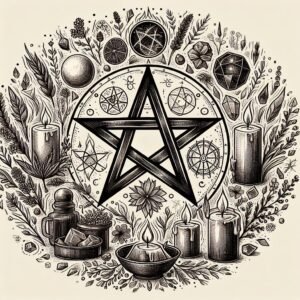
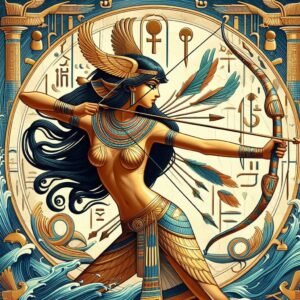

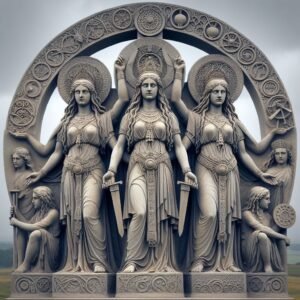

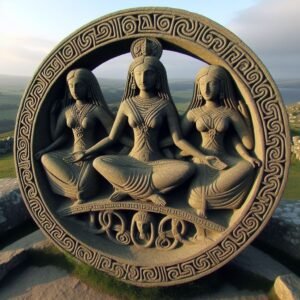
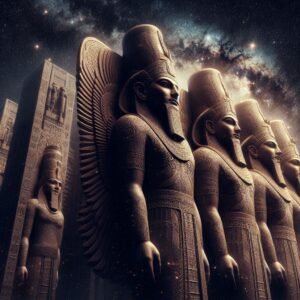

Truth of Self › Forums › Hekate
Tagged: goddess, Greek, Hecate, Hekate, myth, triple goddess